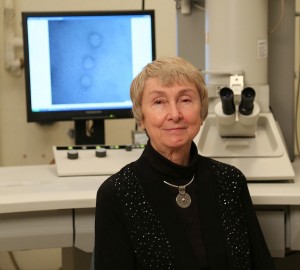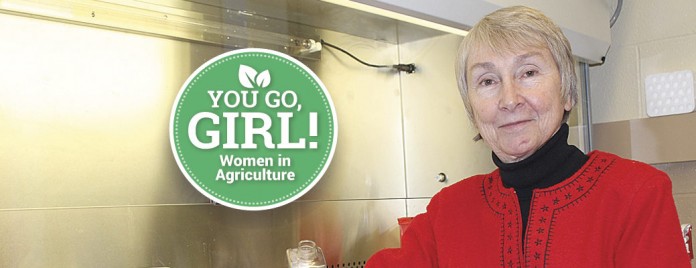WOOSTER, Ohio — When she was a young girl, Linda Saif didn’t exactly get to take the livestock projects to the fair that she wanted.
Her parents were concerned about the time and responsibility it would require from the whole family, so her 4-H experience mostly centered on sewing and cooking, and a few outdoor projects like woodworking and nature.
But Saif, today an acclaimed animal disease researcher for Ohio State University, still owes her love of farm animals and their health to her rural upbringing.
She grew up on her parents’ hobby farm near New Albany, Ohio, where they raised beef cattle, horses, pigs and chickens, and grew and sold produce. Her grandparents also managed a farm near Marietta, which Saif and her siblings still own.
“I was pretty much always interested in that [animal health] because we had livestock — especially if we had a sick animal or something — we tried to find a way to nurse it back to health,” she said.
Those interests are what helped her launch her career in research, which has included major discoveries of viruses and vaccines that have improved both animal and human health.
In May, she will receive one of her highest honors to date, the 2015 Wolf Prize in Agriculture, for her work on viral diseases of critical importance to farm animals, food safety and human health.
She will be the first Ohio State scientist — and the first woman — to receive this recognition, which has been awarded since 1978 by the Wolf Foundation of Israel.
Searching for answers
At the Ohio Agricultural Research and Development Center, where she oversees her own 16-person lab, Saif and her staff are continuously engaged in research to identify viruses, and vaccines that can help control disease.

Currently, her research is focusing on viruses that can sicken both humans and animals, as well as popular coronaviruses such as Porcine Epidemic Diarrhea Virus, or PEDv, which infects the small intestines of baby pigs and causes severe diarrhea and dehydration.
“A lot of our research, we sort of call it ‘dual research,’ in that we’re studying the same disease in both humans and animals,” she said.
Although humans cannot contract PEDv, it cost the livestock industry millions of dollars, and as many as 7 million piglets were lost, according to a June 2014 estimate by the U.S. Department of Agriculture.
Global research
Her work also focuses on viruses and vaccines that affect other countries. In recent years, the world has seen new outbreaks and epidemics, which she said is partly from increased global travel.
“At one time, these were isolated events because people didn’t travel so widely,” she said. “But now that people travel, there’s a lot of global contact.”
The diseases, she said, “are like hitchhikers.” They “go along for the ride,” whether it’s on the airplane, the train or bus.
Saif got her start at the OARDC when she was a student at the College of Wooster in the late 1960s. The college requires students to complete an independent study program, which is similar to an internship, and Saif found herself doing hands-on research and enjoying it.
“That was fascinating to me, so I continued in that area the rest of my career,” she said.
She completed her master’s, doctorate, and postdoctorate degrees at Ohio State, and got her first professorship position with OSU in 1979.
A research family
She also met her husband, Mo Saif, at the same time. He was working on his postdoctorate degree. He went on to become assistant dean in OSU’s College of Veterinary Medicine, and head of the Food Animal Health Research Program at OARDC.
Mo was an acclaimed researcher of poultry diseases — and diseases that can spread from one animal to another.
Combined, Linda and Mo probably have more animal health knowledge under one roof than any other couple worldwide — but they also keep things practical and maintain a lifestyle similar to other rural families.
For many years, they raised Simmental beef on a 70-acre cow-calf operation near Wooster. Their son, Justin, managed the breeding program and showed livestock at the Wayne County Fair.
To this day, Linda still grows, freezes and cans her own vegetables — something she calls a “carryover from my 4-H days.”
Scientific literature
But it’s certainly the scientific world where she’s most known, including the 300-plus journal publications and 58 book chapters that she has helped author.
Her writings include discoveries related to mucosal immunity and vaccines; rotavirus, calicivirus, and animal coronavirus infections; and the use of animal models for human viral diseases.
Saif and her team are particularly known for discovering the “gut-mammary immunologic axis,” which allows swine producers to vaccinate sows orally with a live virus, that in turn delivers an antibody to the sow’s milk and protects her piglets from disease.
According to the Wolf Foundation, Saif’s contributions “have contributed immensely to the improvement of global food safety, food production as well as animal and human health.”
While she’s most known for her discoveries, Saif said there’s also a lot of behind-the-scenes work, like applying for grants to fund the research, and communicating the results to other researchers, as well as the general public.
She has received more than $25 million in competitive grants from U.S. and international agencies, and she speaks out regularly about her discoveries.
She credits 4-H for helping her develop the confidence to do public speaking, and to stand before large crowds.
Opportunity for women
The researchers in Saif’s lab are about half women, and as she sees it, they have as much opportunity in the sciences as anyone.
“I don’t see boundaries now for women,” she said. “I think if you’re willing to work hard and persevere, even sometimes when you know there’s perceived barriers, I think you can overcome those, and I think you can be successful as a woman scientist.”
And, she said, women who do pursue professional careers can still balance their family time, as well.
“They’re not mutually exclusive,” she said. “As long as there’s some flexibility, and the husband helps out a lot, it doesn’t preclude you.”
More women in ag stories:
- Ones to watch: Young women in agriculture April 23, 2015
- At the helm of Ohio Cattlemen’s, Elizabeth Harsh works to ‘be fearless daily’ April 23, 2015
- Farm or nonfarm worlds: Extension dairy specialists know both sides April 16, 2015
- Donniella Winchell puts Ohio wine on the world stage April 2, 2015
- Breaking the ‘grass’ ceiling: East Ohio Women in Agriculture Conference draws 135 March 30, 2015
- Annie Warmke: Back to the Earthship March 26, 2015
- Leah Miller helps farmers, communities get things done March 19, 2015
- Judy Ligo: ‘I had to prove I knew what I was doing’ March 12, 2015
- Pitching farm life: Brenda Hastings takes dairy industry in an all new direction March 5, 2015
- The ones to watch: Help us find the millennials who will be tomorrow’s leaders in agriculture March 5, 2015
- It’s OK to ‘farm like a girl’ March 5, 2015










